C-Band SAR Winds for Tropical Cyclone Monitoring and Forecast in the South-West Indian Ocean
Abstract
:1. Introduction
2. SAR Data during the 2018–2019 TC Season in the SWIO
3. AROME OI 3D-Var
4. SAR Assessment
4.1. Assessment with AROME OI 3D-Var Analyses
4.2. Assessment with Best Track Database
5. Assimilation of SAR Data with AROME 3D-Var
5.1. Case of TC GELENA
5.1.1. Description of Cyclone GELENA
5.1.2. Impact on Analyses
5.1.3. Impact on Forecasts
5.1.4. Sensitivity Tests
5.2. Case of TC IDAI
5.2.1. Description of Cyclone IDAI
5.2.2. Impact on Analyses
5.2.3. Impact on Forecasts
5.2.4. Sensitivity Tests
6. Discussion and Conclusions
Author Contributions
Funding
Institutional Review Board Statement
Informed Consent Statement
Data Availability Statement
Acknowledgments
Conflicts of Interest
References
- Mouche, A.A.; Chapron, B.; Zhang, B.; Husson, R. Combined Co- and Cross-Polarized SAR Measurements Under Extreme Wind Conditions. IEEE Trans. Geosci. Remote Sens. 2017, 55, 6746–6755. [Google Scholar] [CrossRef]
- Bentamy, A.; Croize-Fillon, D.; Perigaud, C. Characterization of ASCAT measurements based on buoy and QuikSCAT wind vector observations. Ocean Sci. 2008, 4, 265–274. [Google Scholar] [CrossRef] [Green Version]
- Bousquet, O.; Barruol, G.; Cordier, E.; Barthe, C.; Bielli, S.; Calmer, R.; Rindraharisaona, E.; Roberts, G.; Tulet, P.; Amelie, V.; et al. Impact of Tropical Cyclones on Inhabited Areas of the SWIO Basin at Present and Future Horizons. Part 1: Overview and Observing Component of the Research Project RENOVRISK-CYCLONE. Atmosphere 2021, 5, 544. [Google Scholar] [CrossRef]
- Barthe, C.; Bousquet, O.; Bielli, S.; Tulet, P.; Pianezze, J.; Claeys, M.; Tsai, C.-L.; Thompson, C.; Bonnardot, F.; Chauvin, F.; et al. Impact of tropical cyclones on inhabited areas of the SWIO basin at present and future horizons. Part 2: Modelling component of the research program RENOVRISK-CYCLONE. Atmosphere 2021. submitted. [Google Scholar]
- Tulet, P.; Aunay, B.; Barruol, G.; Barthe, C.; Belon, R.; Bielli, S.; Bonnardot, F.; Bousquet, O.; Cammas, J.P.; Cattiaux, J.; et al. ReNovRisk: A multidisciplinary programme to study the cyclonic risks in the South-West Indian Ocean. Nat. Hazards 2021. [Google Scholar] [CrossRef]
- Duan, B.; Zhang, W.; Yang, X.; Dai, H.; Yu, Y. Assimilation of Typhoon Wind Field Retrieved from Scatterometer and SAR Based on the Huber Norm Quality Control. Remote Sens. 2017, 9, 987. [Google Scholar] [CrossRef] [Green Version]
- Yu, Y.; Yang, X.; Zhang, W.; Duan, B.; Cao, X.; Leng, H. Assimilation of Sentinel-1 Derived Sea Surface Winds for Typhoon Forecasting. Remote Sens. 2017, 9, 845. [Google Scholar] [CrossRef] [Green Version]
- Hersbach, H. Comparison of C-Band Scatterometer CMOD5.N Equivalent Neutral Winds with ECMWF. J. Atmos. Ocean. Technol. 2010, 27, 721–736. [Google Scholar] [CrossRef]
- Fernandez, D.E.; Carswell, J.R.; Frasier, S.; Chang, P.S.; Black, P.G.; Marks, F.D. Dual-polarized C- and Ku-band ocean backscatter response to hurricane-force winds. J. Geophys. Res. Ocean. 2006, 111. [Google Scholar] [CrossRef] [Green Version]
- Vachon, P.W.; Wolfe, J. C-Band Cross-Polarization Wind Speed Retrieval. IEEE Geosci. Remote Sens. Lett. 2011, 8, 456–459. [Google Scholar] [CrossRef]
- Mouche, A.; Chapron, B.; Knaff, J.; Zhao, Y.; Zhang, B.; Combot, C. Copolarized and Cross-Polarized SAR Measurements for High-Resolution Description of Major Hurricane Wind Structures: Application to Irma Category 5 Hurricane. J. Geophys. Res. Ocean. 2019, 124, 3905–3922. [Google Scholar] [CrossRef]
- Husson, R.; Mouche, A.; Johnsen, H.; Collard, F.; Engen, G.; Longepe, N.; Guitton, G.; Wang, H.; Wang, X.; Soulat, F.; et al. Sentinel-1 Achievements for Ocean and Extreme Events Monitoring. In Proceedings of the IGARSS 2018–2018 IEEE International Geoscience and Remote Sensing Symposium, Valencia, Spain, 22–27 July 2018; pp. 1573–1576. [Google Scholar] [CrossRef]
- Foster, R.C. Why Rolls are Prevalent in the Hurricane Boundary Layer. J. Atmos. Sci. 2005, 62, 2647–2661. [Google Scholar] [CrossRef]
- Morrison, I.; Businger, S.; Marks, F.; Dodge, P.; Businger, J.A. An observational case for the prevalence of roll vortices in the hurricane boundary layer. J. Atmos. Sci. 2005, 62, 2662–2673. [Google Scholar] [CrossRef] [Green Version]
- Koch, W. Directional analysis of SAR images aiming at wind direction. IEEE Trans. Geosci. Remote Sens. 2004, 42, 702–710. [Google Scholar] [CrossRef]
- Seity, Y.; Brousseau, P.; Malardel, S.; Hello, G.; Bénard, P.; Bouttier, F.; Lac, C.; Masson, V. The AROME-France Convective-Scale Operational Model. Mon. Weather Rev. 2011, 139, 976–991. [Google Scholar] [CrossRef] [Green Version]
- Bousquet, O.; Barbary, D.; Bielli, S.; Kebir, S.; Raynaud, L.; Malardel, S.; Faure, G. An evaluation of tropical cyclone forecast in the Southwest Indian Ocean basin with AROME-Indian Ocean convection-permitting numerical weather predicting system. Atmos. Sci. Lett. 2020, 21, e950. [Google Scholar] [CrossRef]
- Brousseau, P.; Seity, Y.; Ricard, D.; Léger, J. Improvement of the forecast of convective activity from the AROME-France system. Q. J. R. Meteorol. Soc. 2016, 142, 2231–2243. [Google Scholar] [CrossRef]
- Mogensen, K.S.; Magnusson, L.; Bidlot, J.R. Tropical cyclone sensitivity to ocean coupling in the ECMWF coupled model. J. Geophys. Res. Ocean. 2017, 122, 4392–4412. [Google Scholar] [CrossRef]
- Montmerle, T.; Berre, L. Diagnosis and formulation of heterogeneous background-error covariances at the mesoscale. Q. J. R. Meteorol. Soc. 2010, 136, 1408–1420. [Google Scholar] [CrossRef]
- Ravela, S.; Emanuel, K.; McLaughlin, D. Data assimilation by field alignment. Phys. D Nonlinear Phenom. 2007, 230, 127–145. [Google Scholar] [CrossRef]
- Tropical Cyclone Operational Plans. Available online: https://community.wmo.int/tropical-cyclone-operational-plans (accessed on 15 February 2021).
- Dvorak, V. Tropical cyclone intensity analysis and forecasting from satellite imagery. Mon. Weather Rev. 1975, 103, 420–430. [Google Scholar] [CrossRef]
- Dvorak, V. Tropical cyclone intensity analysis using satellite data. NOAA Tech. Rep. 1984, 11, 1–47. [Google Scholar]
- SAROPS Tropical Cyclone Winds. Available online: https://www.star.nesdis.noaa.gov/socd/mecb/sar/AKDEMO_products/APL_winds/tropical/index.html (accessed on 15 February 2021).
- Dvorak, V.; Kepert, J.; Ginger, J. Guidelines for Converting between Various Wind Averaging Periods in Tropical Cyclone Conditions; WMO/TD 1555; World Meteorological Organization: Geneva, Switzerland, 2010. [Google Scholar]
- Knaff, J.; Brown, D.; Courtney, J.; Gallina, G.; Beven, J. An Evaluation of Dvorak Technique-Based Tropical Cyclone Intensity Estimates. Weather Forecast. 2010, 25, 1362–1379. [Google Scholar] [CrossRef]
- Powell, M.D.; Reinhold, T.A. Tropical Cyclone Destructive Potential by Integrated Kinetic Energy. Bull. Am. Meteorol. Soc. 2007, 88, 513–526. [Google Scholar] [CrossRef] [Green Version]
- Combot, C.; Mouche, A.; Knaff, J.; Zhao, Y.; Zhao, Y.; Vinour, L.; Quilfen, Y.; Chapron, B. Extensive High-Resolution Synthetic Aperture Radar (SAR) Data Analysis of Tropical Cyclones: Comparisons with SFMR Flights and Best Track. Mon. Weather Rev. 2020, 148, 4545–4563. [Google Scholar] [CrossRef]
- Liu, Z.Q.; Rabier, F. The interaction between model resolution, observation resolution and observation density in data assimilation: A one-dimensional study. Q. J. R. Meteorol. Soc. 2002, 128, 1367–1386. [Google Scholar] [CrossRef] [Green Version]
- Bonavita, M.; Dahoui, M.; Lopez, P.; Prates, F.; Hólm, E.; Chiara, G.D.; Geer, A.J.; Isaksen, L.; Ingleby, B. On the Initialization of Tropical Cyclones; Technical Report 810; ECMWF: Reading, UK, 2017. [Google Scholar] [CrossRef]
- Emanuel, K.; Zhang, F. On the Predictability and Error Sources of Tropical Cyclone Intensity Forecasts. J. Atmos. Sci. 2016, 73, 3739–3747. [Google Scholar] [CrossRef] [Green Version]
- Zhang, S.; Li, T.; Ge, X.; Peng, M.; Pan, N. A 3DVAR-Based Dynamical Initialization Scheme for Tropical Cyclone Predictions. Weather Forecast. 2012, 27, 473–483. [Google Scholar] [CrossRef] [Green Version]
- Bing, L.; Bin, W.; Ying, Z. Numerical Simulation of a Landfall Typhoon Using a Bogus Data Assimilation Scheme. Atmos. Ocean. Sci. Lett. 2011, 4, 242–246. [Google Scholar] [CrossRef]
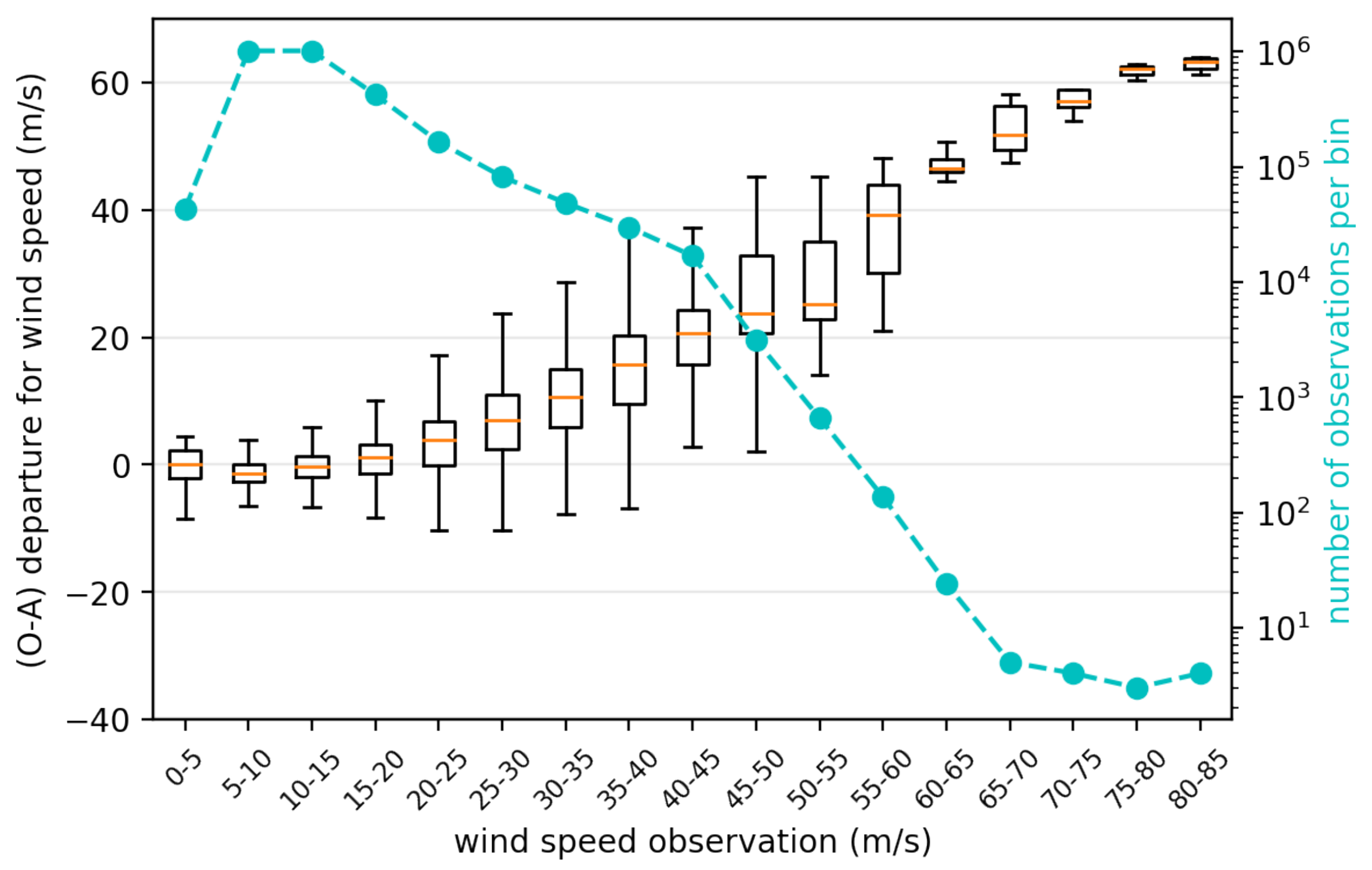


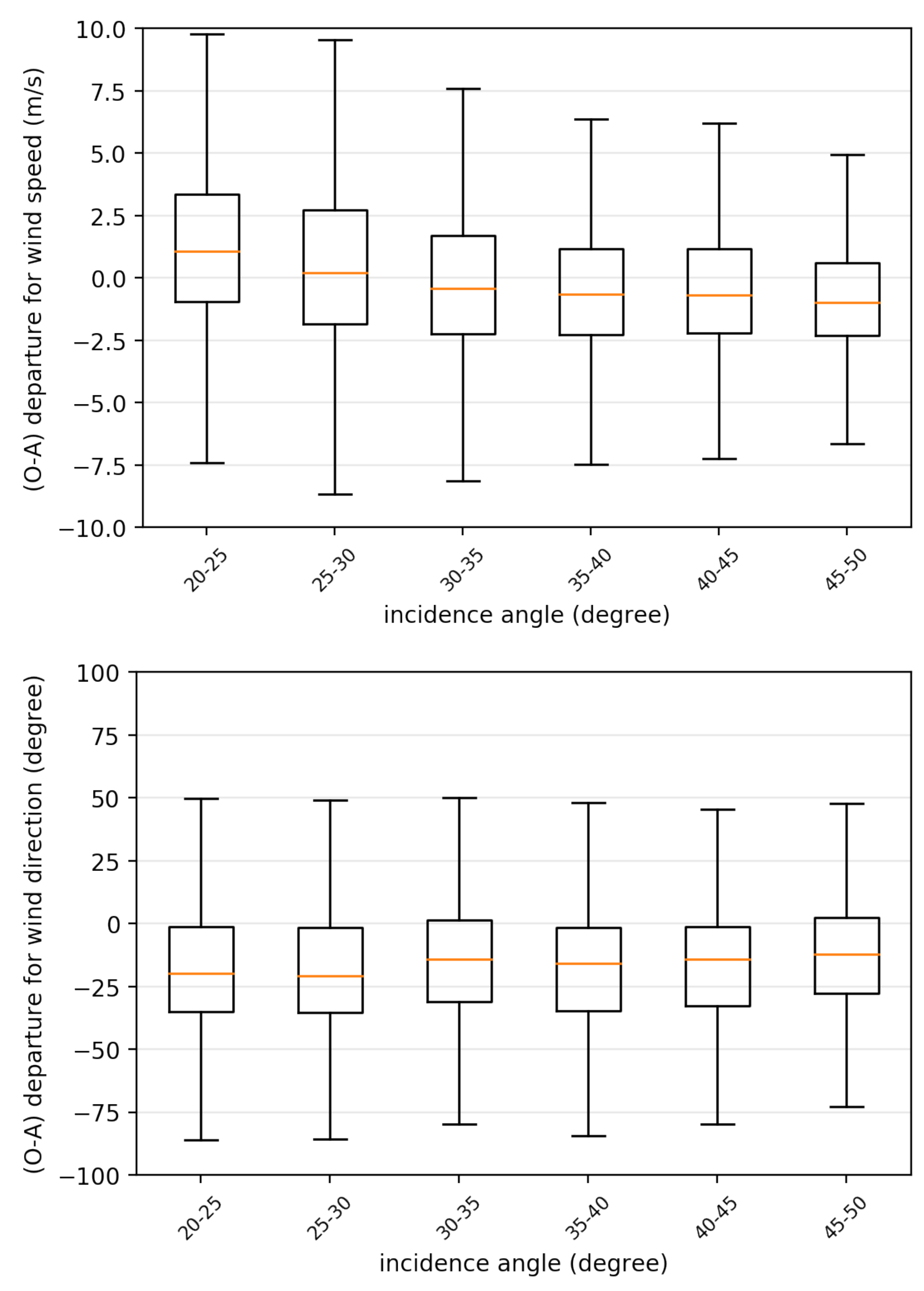




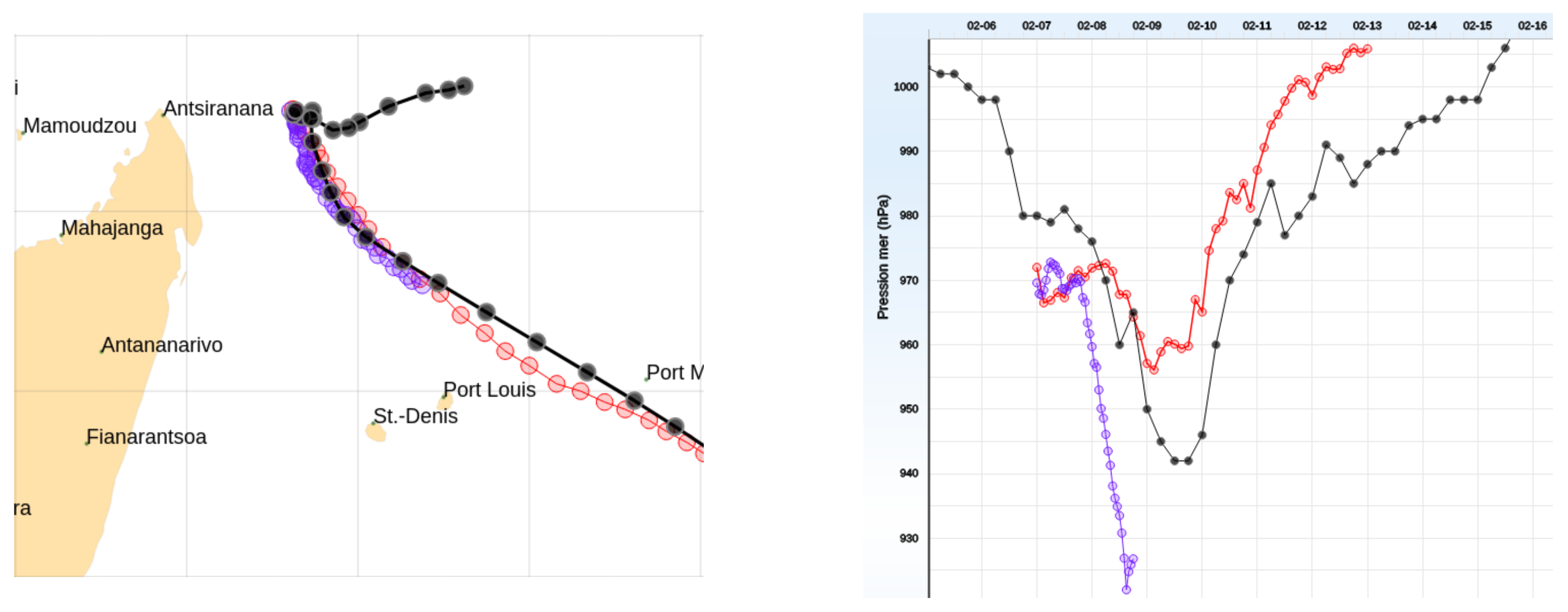


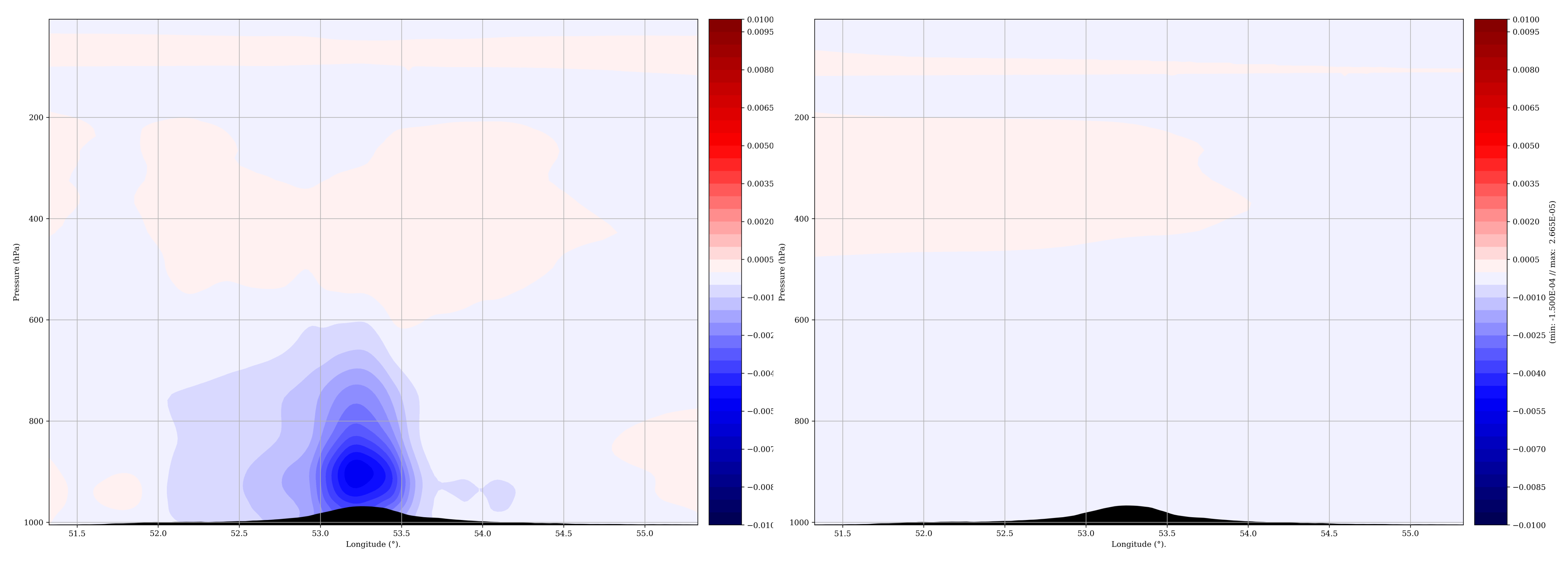
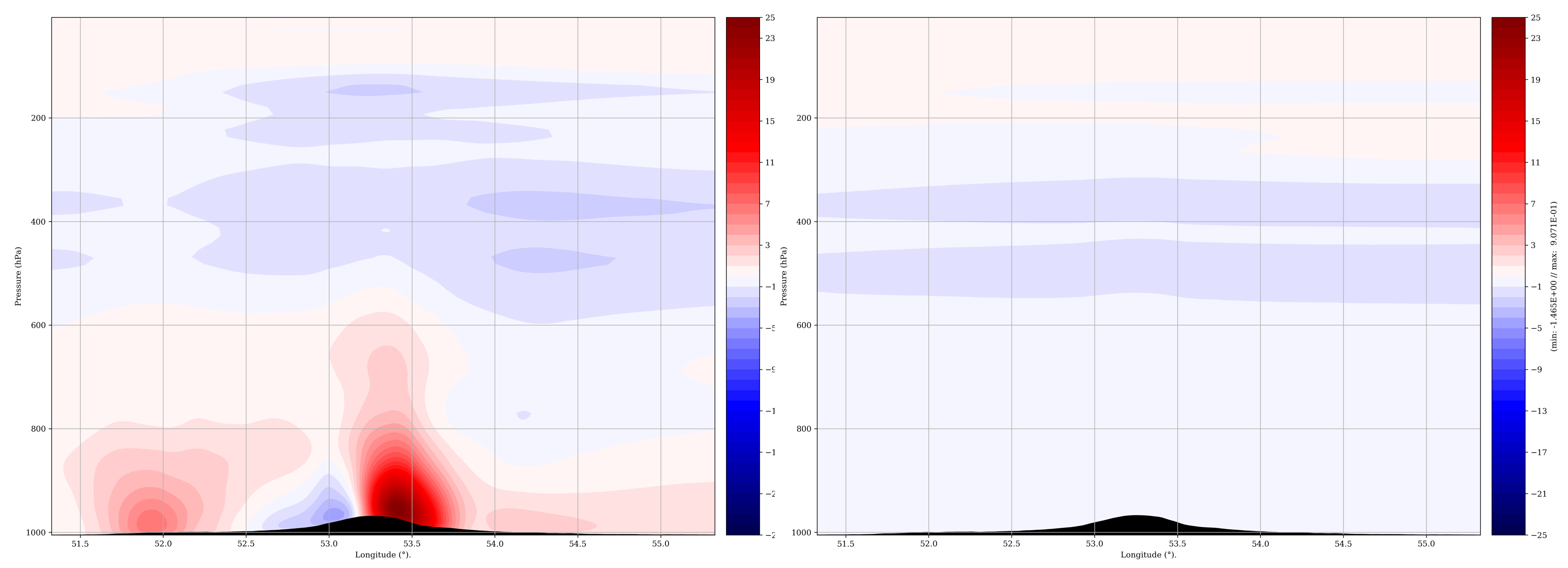

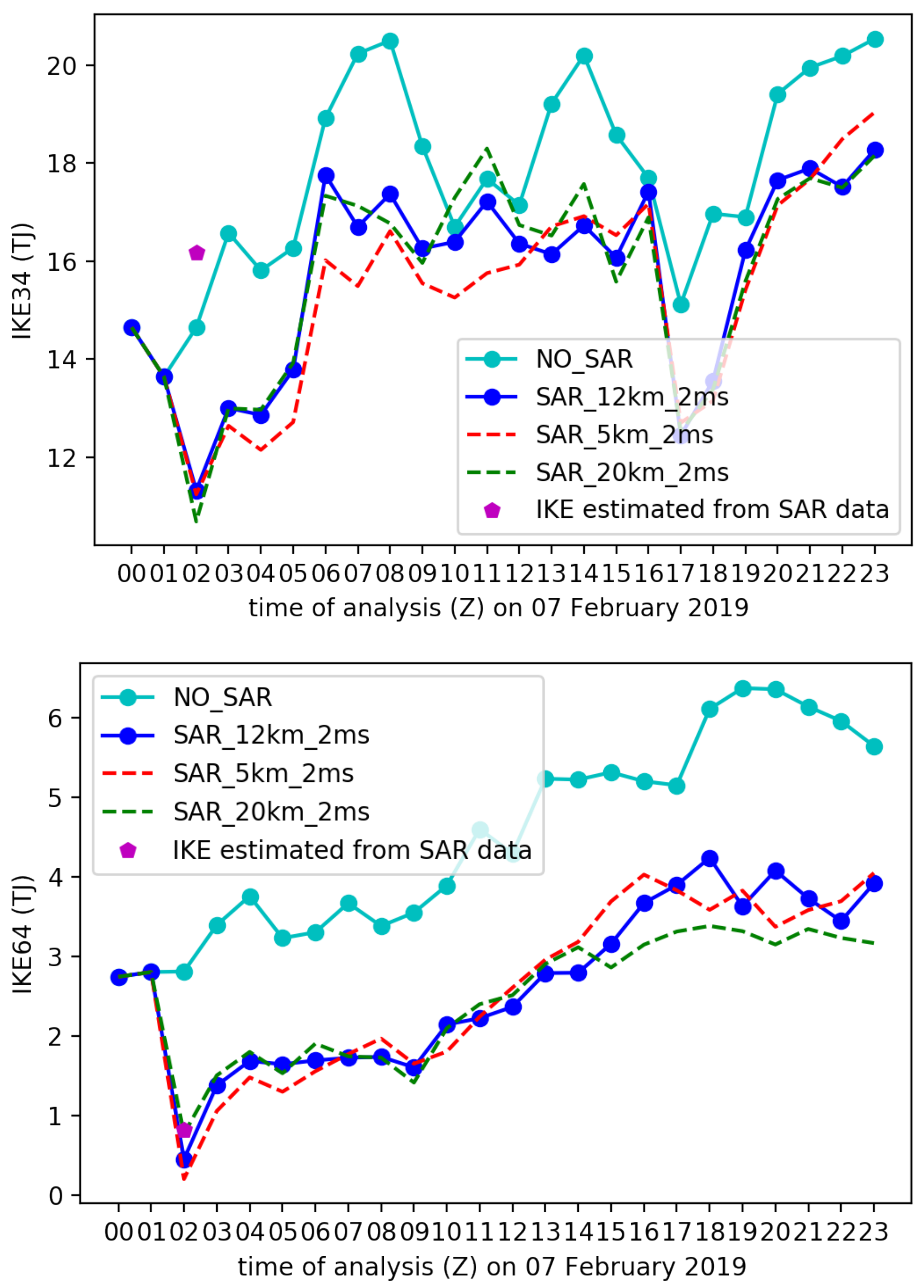
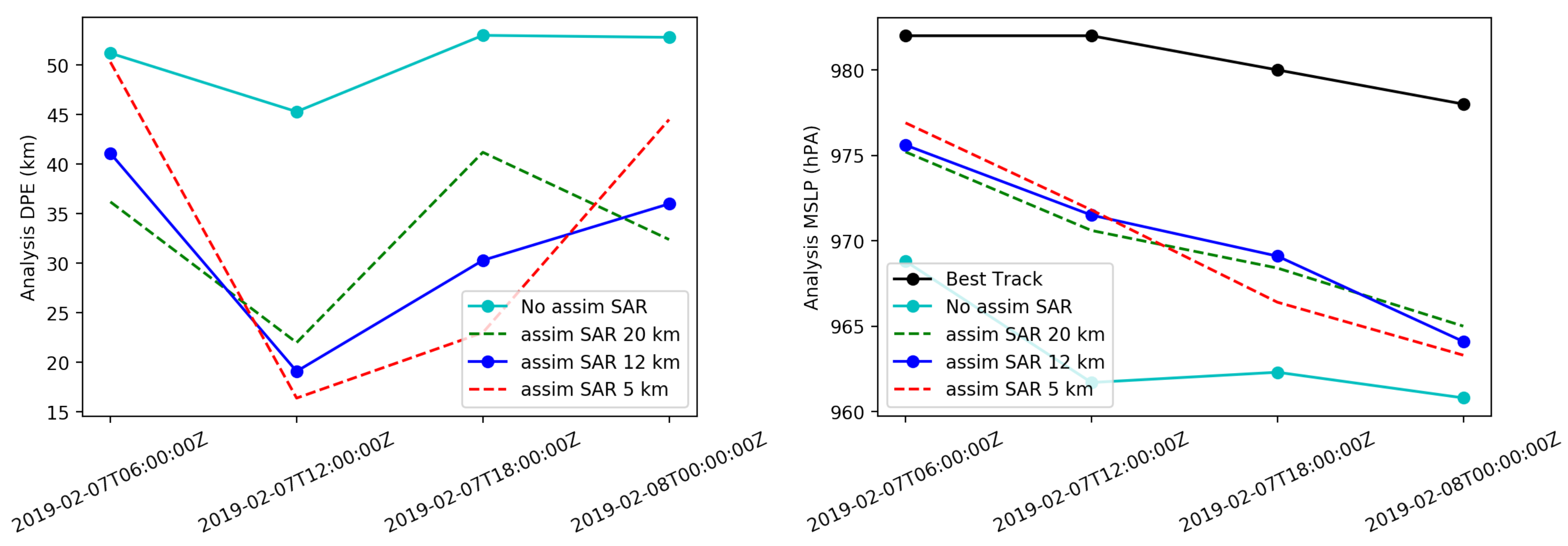


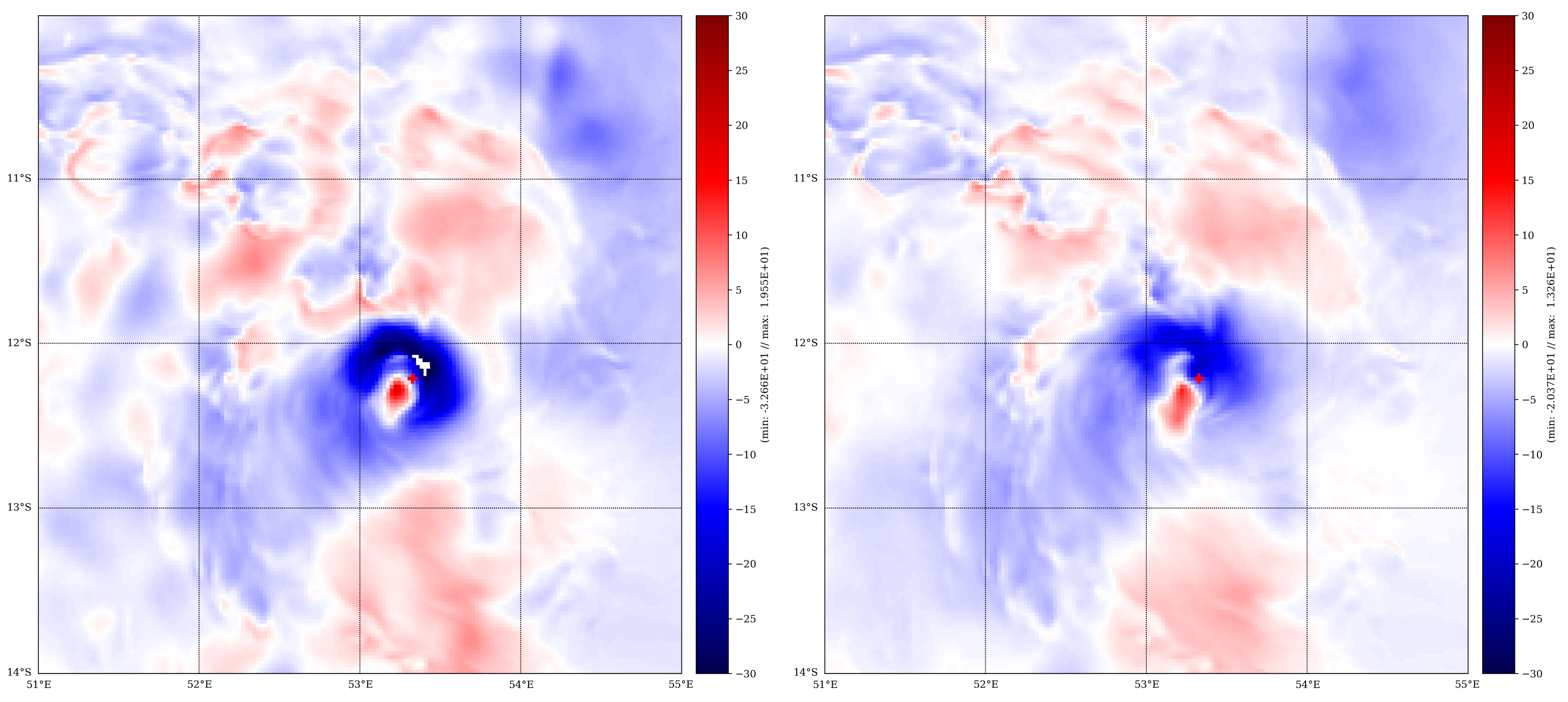




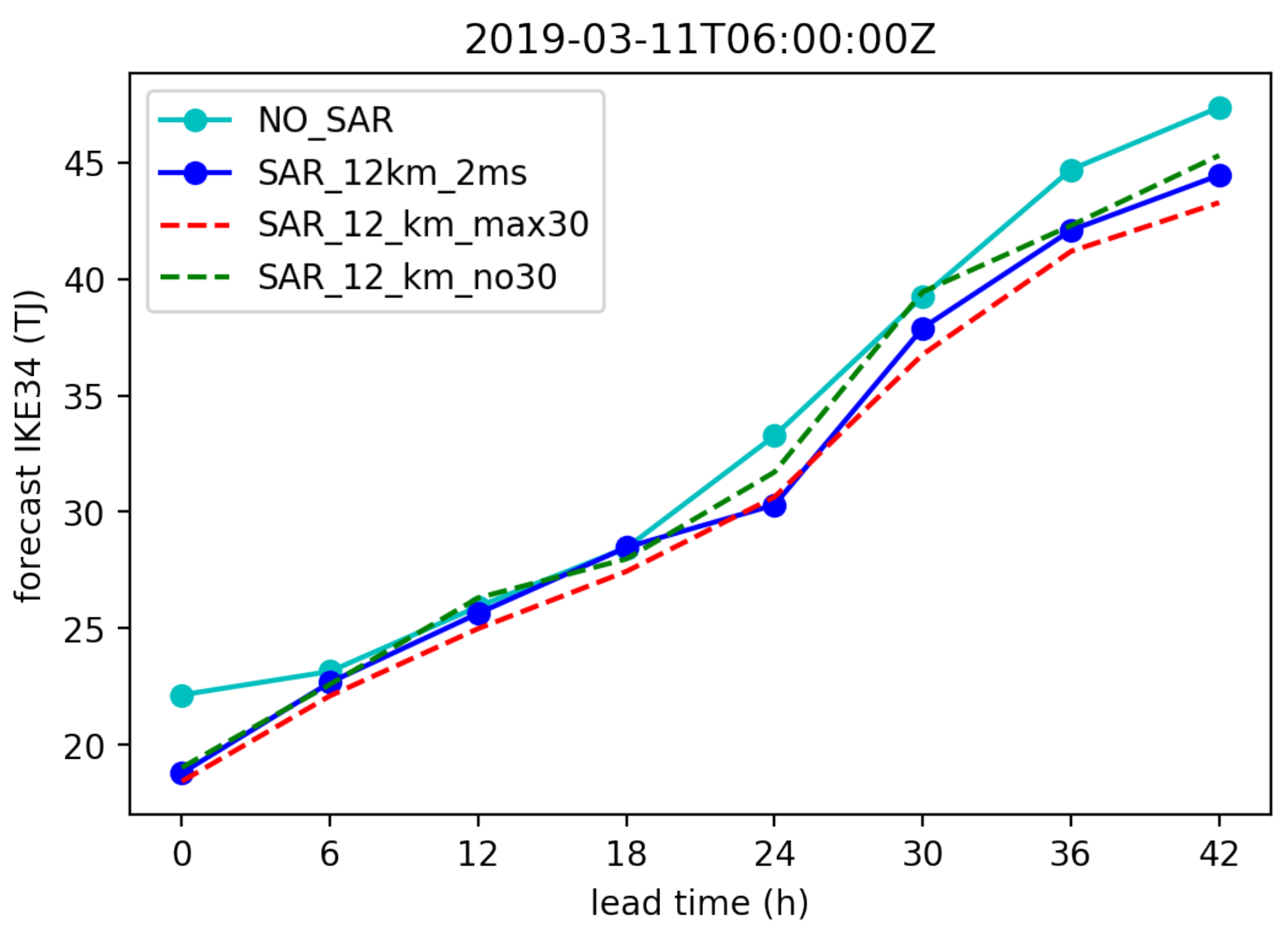
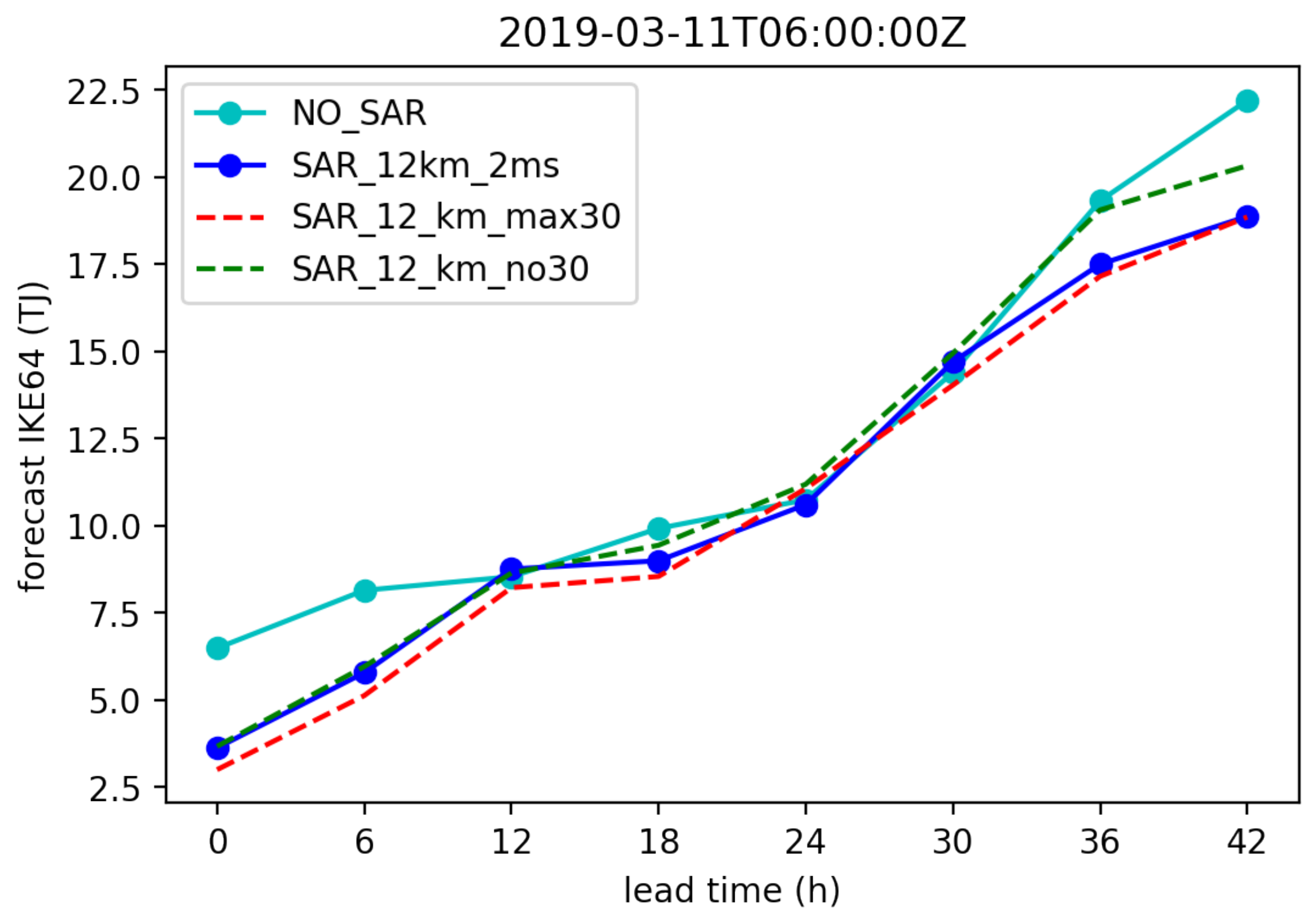


| Date of Acquisition | TC Name | Acq. Mode | Nb of Obs. | Eye Detection |
|---|---|---|---|---|
| 7 February 2019 02:09Z | GELENA | EW | 342,403 | yes |
| 8 February 2019 02:01Z | GELENA | EW | 400,862 | yes |
| 9 February 2019 01:53Z | GELENA | EW | 414,219 | no |
| 11 March 2019 02:46Z | IDAI | IW | 325,023 | yes |
| 14 March 2019 03:09Z | IDAI | IW | 45,205 | no |
| 14 March 2019 16:06Z | IDAI | IW | 126,558 | yes |
| 26 March 2019 01:29Z | JOHANINHA | EW | 465,417 | no |
| 28 March 2019 01:13Z | JOHANINHA | EW | 338,929 | no |
| 29 March 2019 14:03Z | JOHANINHA | EW | 339,233 | no |
| 30 March 2019 00:58Z | JOHANINHA | EW | 259,783 | no |
| 30 March 2019 13:54Z | JOHANINHA | EW | 131,013 | no |
| 31 March 2019 00:50Z | JOHANINHA | EW | 67,619 | no |
Publisher’s Note: MDPI stays neutral with regard to jurisdictional claims in published maps and institutional affiliations. |
© 2021 by the authors. Licensee MDPI, Basel, Switzerland. This article is an open access article distributed under the terms and conditions of the Creative Commons Attribution (CC BY) license (https://creativecommons.org/licenses/by/4.0/).
Share and Cite
Duong, Q.-P.; Langlade, S.; Payan, C.; Husson, R.; Mouche, A.; Malardel, S. C-Band SAR Winds for Tropical Cyclone Monitoring and Forecast in the South-West Indian Ocean. Atmosphere 2021, 12, 576. https://doi.org/10.3390/atmos12050576
Duong Q-P, Langlade S, Payan C, Husson R, Mouche A, Malardel S. C-Band SAR Winds for Tropical Cyclone Monitoring and Forecast in the South-West Indian Ocean. Atmosphere. 2021; 12(5):576. https://doi.org/10.3390/atmos12050576
Chicago/Turabian StyleDuong, Quoc-Phi, Sébastien Langlade, Christophe Payan, Romain Husson, Alexis Mouche, and Sylvie Malardel. 2021. "C-Band SAR Winds for Tropical Cyclone Monitoring and Forecast in the South-West Indian Ocean" Atmosphere 12, no. 5: 576. https://doi.org/10.3390/atmos12050576






